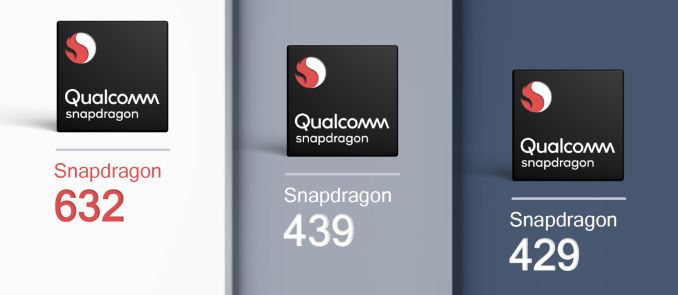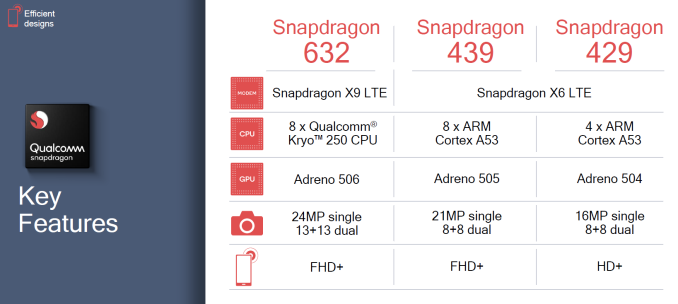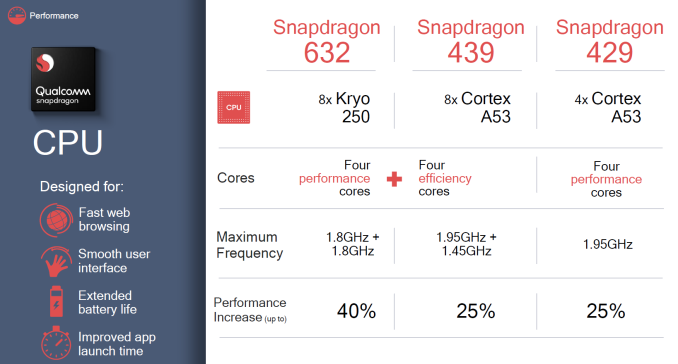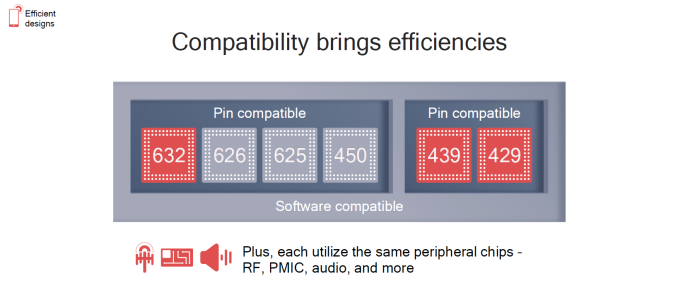A month ago we saw Qualcomm release a new “upper mid-range” SoC with the announcement of the Snapdragon 710 – the emphasis was on the fact that this was a new market tier aiming slightly below the top-tier flagship chipsets. Today, we’re seeing Qualcomm expand the traditional mid-tier and also what can be considered the low-end for smartphone devices. The Snapdragon 439 and 429 follow in the footsteps of the 435 and 425 and bring FinFET to the low-end; the Snapdragon 632 is more akin to the Snapdragon 652 as it’s now the first time we see big cores brought down to the lower mid-tier successor to the Snapdragon 630.
| New 2018 Mid & Low-End Snadpragons | ||||
| SoC | Snapdragon 632 | Snapdragon 439 | Snapdragon 429 | |
| CPU | 4x Kryo 250 (CA72?) @ 1.8GHz 4x Kryo 250 (CA53) @ 1.8GHz |
4x A53 @ 1.95GHz 4x A53 @ 1.45 GHz |
4x A53 @ 1.95 | |
| GPU | Adreno 506 | Adreno 505 | Adreno 504 | |
| Modem | "X9 LTE" Cat. 7/13 300Mbps DL 150Mbps UL 4x10MHz C.A. (DL & 2CA UL) |
"X6 LTE" Cat. 4/5 150Mbps DL 75Mbps UL 2x10MHz C.A. (DL) |
||
| Camera/ISP | Dual ISP 24MP / 13+13MP |
Dual ISP 21MP / 8+8MP |
Dual ISP 16MP / 8+8MP |
|
| Mfc. Process | 14nm FinFET | |||
Starting off with the Snapdragon 632 the new chipset is positioned as a successor to the Snapdragon 630. The 600 series suffered from quite a bit of naming confusion as we saw very large performance differences between the 65x and 66x series and the lower numbered ones such as the Snapdragon 630, 615 and 617 – this was largely due to the fact that the lower 600 series SoCs were missing the processing power of larger “big” CPU microarchitecture cores, while the 650 and up were effectively positioned as more expensive tiers.
The Snapdragon 632 now continues this lower-tiered positioning within the 600 series, but brings for the first time the performance benefit of big cores to this price segment. We find 4x Kryo 250 up to 1.8GHz – Qualcomm didn’t confirm what CPU this is based on but looking at the CPUID of an unannounced device it matched the Cortex A72 and this would also make sense given the lower Kryo 2xx naming scheme. The big cores are paired with 4x Kryo 250’s – but again we’re effectively talking about Cortex A53 cores as the little cores in the efficiency cluster.
The Snapdragon 439 and 429 are direct successors to the 435 and 425. The S435 is a 8x A53 setup with a performance cluster going up to 1.95GHz while the second efficiency cluster goes up to 1.45GHz. The S429 is a simple single-cluster with 4x Cortex A53’s up to 1.95GHz and comes with a more updated Adreno 504 over the 425’s older Adreno 308 with the largest quoted performance improvement of up to 50%.
One of the most important characteristics of these new low-end SoCs is however that they’re manufactured on FinFET nodes – Qualcomm didn’t specify exactly the foundry or exact node but we’re likely talking about 14LPP or a 16FF variant, with the possibility of Qualcomm also third-sourcing these from UMC as well. This marks a generational shift as we see Qualcomm effectively have completed a total transition to FinFET products across its whole mobile SoC product line.
A large commercial advantage of the new chips is their design compatibility; the Snapdragon 632, 439, 429 are software compatible with each other and with the existing 626, 625 and 450 platforms. Furthermore the 632 is pin compatible with the 626, 625 and 450, and the 439 and 429 are pin compatible with each other. The software compatibility means less resource investment on the part of OEMs and accelerated time-to-market for devices. In particular what seems to be very interesting here is the 632 being pin compatible with several older chips – It would be great to see OEMs be able to release quick refreshes of their devices with the new chip given that it’ll bring large performance improvements thanks to the new big CPU cores.
Overall the new mid- and low-end Snapdragons bring a generational improvement thanks to Qualcomm’s total switch to FinFET nodes across all of its line-up. The new SoC platforms are quoted be used in commercial devices released in the second half of 2018, which essentially means very soon.
from AnandTech https://ift.tt/2tLrOxc
via IFTTT











No comments:
Post a Comment